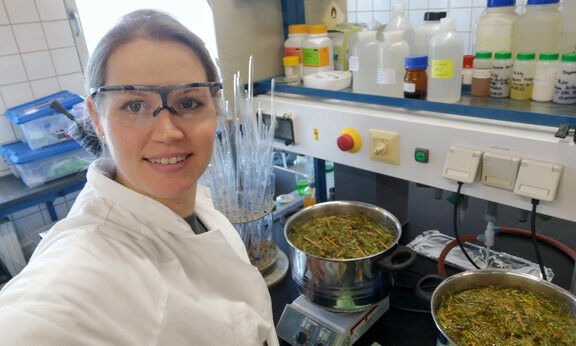Printing inks produced from crops

At the trail to a round economic system, Judith Deriu is growing herbal colour pigments from crops and makes use of them to produce sustainable printing inks for trade within the laboratory on the Analysis Institute of Textile Chemistry and Textile Physics in Dornbirn.
Herbal dyes had been worn via people for hundreds of years. Indigo, carmine, red and ultramarine had been recognized since precedent days and have been best changed via artificial dyes all the way through the economic revolution. The Analysis Institute for Textile Chemistry and Textile Physics in Dornbirn has been researching herbal dyes for over 25 years. In spite of a pattern in opposition to ecological uncooked fabrics, herbal dyes have now not but been in a position to ascertain themselves within the textile trade. They lose their colour depth extra briefly when washed and uncovered to daylight and are costlier to put together than their artificial competition.
Then again, the trade’s pastime in sustainable merchandise is rising strongly. At the one hand, that is because of stricter regulation within the segment of sustainability and the round economic system. At the alternative hand, environmental consciousness and the willingness of customers to spend more cash on ecological and sustainable merchandise is rising. Herbal dyes and herbal pigments are already being worn effectively within the meals and cosmetics industries. Judith Deriu has been operating on the Analysis Institute of Textile Chemistry and Textile Physics since 2016 and objectives to give a contribution to the advance of the round economic system within the textile sector together with her analysis. She is continuous the institute’s custom and the usage of an historic procedure that can be used to put together pigments from crops. “Unfortunately, a lot of knowledge has been lost here,” says the chemist. “In the laboratory, I try to optimize this process to such an extent that industrial partners can test the pigments for different applications in practice.”
The colours of nature
Judith Deriu is basically on the lookout for purple and blue sunglasses, as those have up to now been in large part absent from the colour palette in response to herbal dyes. “We are still working on this because these pigments are chemically very unstable,” explains the researcher. Then again, there are already formulations for yellow, ochre, olive inexperienced, brown, beige and dark which are fascinating for business virtue. The pigments are in response to squander fabrics from forestry, agriculture and the meals trade in addition to alternative non-food crops. Dull may also be received as log squander from sawmills, olive inexperienced from onion skins, blue from blueberries and blue-green algae and purple from grapes and berries. Indigo and madder are intentionally now not worn as they can’t be produced successfully in Central Europe. Judith Deriu avoids the usage of plant-based uncooked fabrics from separate international locations as a result of the lengthy transportation routes and the related CO2 emissions.
However it’s not best the colour pigments which are in response to renewable uncooked fabrics; binders and fibers required for the manufacturing of printing inks also are to get replaced. Judith Deriu is on the lookout for herbal possible choices to business merchandise produced from crude oil. “Materials made from fossil raw materials have a high impact on nature,” says the chemist. “Microfibers are released from synthetic textiles that cannot be broken down, and artificial binders with pigments are released into the environment as microplastics from the motifs printed on textiles.” The Dornbirn scientists virtue their plant pigments to paint bio-based cellulose fibers, as an example, which can be created from log the usage of an business procedure. For printing on textiles and paper, Deriu is checking out sustainable binders in response to biodegradable polysaccharides to bring to keep away from the starting of microplastics.
Marketable merchandise
Numerous printing inks are evolved in collaboration with trade companions. Paper printing inks for offset printing produced from sustainable vegetable oils and resins may also be made utterly sustainable with the plant pigments. “However, our pigment particles are still too large for paper printing, they have to be smaller than 3 micrometers,” says the chemist. The ends up in textile printing, at the alternative hand, are very promising. “Together with our partners, we are currently looking for products that can be marketed.” Buying groceries baggage or tournament T-shirts, as an example, are conceivable applicants. Within the paper sector, wrapping paper, packaging fabrics and paper baggage are conceivable farmlands of software for the unutilized colour piments and printing inks. For clothes, the goods nonetheless wish to be evolved considerably in order that they are able to face up to widespread bath.
Cooperation with trade additionally creates the root for a community of science, industry and all the ones concerned alongside the price chain. Judith Deriu’s challenge crew comprises, as an example, textile printers Buntwerk from Vorarlberg, Kelheim Anecdotes, the sector’s eminent producer of viscose area of expertise fibers, Solar Chemical, essentially the most notable producer of printing inks, and Verpackungszentrum Graz, the Austrian specialist for ecological packaging. “To truly establish a circular economy in the textile and printing industry, everyone involved must work together: Science, industry and consumers. My research is a small piece of the puzzle in this joint effort,” says Judith Deriu.
At the researcher
Judith Deriu (*1986) used to be born in Switzerland and studied biomedicine in Amsterdam. In 2016, she joined the Analysis Institute for Textile Chemistry and Textile Physics on the College of Innsbruck for a doctorate and has been carrying out analysis right here as a postdoc since finishing her doctorate. She is head of an FFG challenge on Plant Pigments as sustainable and biodegradable Colorants for coloring Textiles and Paper (PiColor). .
This newsletter seemed in factor 02/23 of the analysis brochure zukunft forschung of the College of Innsbruck.
Universität Innsbruck Univesität Innsbruck Universität Innsbruck Universität Innsbruck Universität Innsbruck Universität Innsbruck Universität Innsbruck privat




